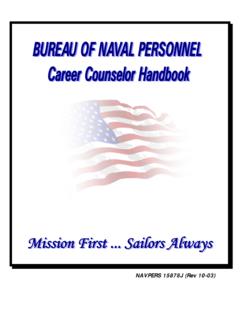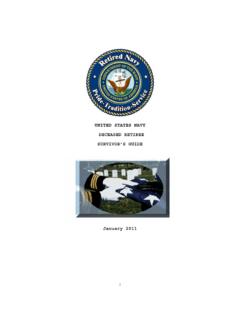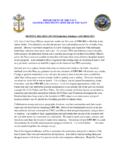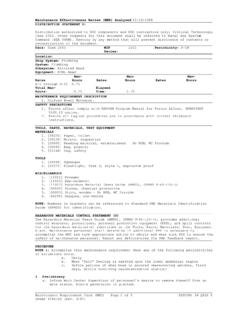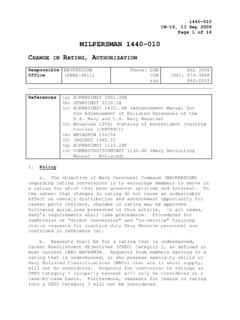Transcription of OPNAVINST 1306.2F N1 OPNAV INSTRUCTION 1306
1 OPNAVINST N1. 1 Apr 2011. OPNAV INSTRUCTION From: Chief of Naval Operations Subj: COMMAND MASTER CHIEF PROGRAM. Ref: (a) OPNAVINST (b) MILPERSMAN. (c) DoD Financial Management Regulation , Military Pay, Policy and Procedures Manual, Volume 7A, 2 Sep 2010. (d) Navy Uniform Regulations (e) OPNAVINST Encl: (1) Fleet Master Chief, Force Master Chief, Command Master Chief, Chief of the Boat, and Command Senior Chief Program Selection, Responsibilities, and Billet Requirements (2) Flag/General Officer CMC Selection Process 1. Purpose. To issue procedures for selection, assignment, and utilization of fleet master chiefs (FLTCM), force master chiefs (FORCM), command master chiefs (CMC), chiefs of the boat (COB), command senior chiefs (CSC), and collateral duty command senior enlisted leaders (CSEL) per references (a) through (e).
2 This INSTRUCTION is a complete revision and should be reviewed in its entirety. 2. Cancellation. OPNAVINST 3. Discussion. The Command Master Chief Program is intended to ensure Sailors are effectively led and developed. Senior enlisted Sailors selected for these programs are responsible for leading the alignment efforts of the chief's mess with the Navy ethos, Navy core values, and the Master Chief Petty Officer of the Navy's (MCPON's) mission, vision, and guiding principles. They are also charged with ensuring active communication throughout the chain of command. 4. Action. Eligible Sailors shall be selected and assigned as delineated in enclosures (1) and (2).
3 NAVPERS 1306 /95 Command Master Chief Selection Nomination must be submitted with each application package. OPNAVINST 1 Apr 2011. 5. Billets. All FLTCM, FORCM, CMDCM, CSC, and COB billets existing at the time of this INSTRUCTION , and any billet that is created through the billet change request (BCR) process, are considered official requirements and do not need further validation. 6. Records Management. Records created as a result of this INSTRUCTION , regardless of media and format, shall be managed per Secretary of the Navy Manual of November 2007. 7. Forms a. The following forms are available for download from Naval Forms Online at : (1) NAVPERS 1306 /7 (1/2003) Enlisted Personnel Action Request.
4 (2) NAVPERS 1070/613 (7/2006) Administrative Remarks;. (3) NAVPERS 1306 /95 (4/2010) Command Master Chief Selection Nomination; and (4) OPNAV 1306 /1 (9/2010) CMC/COB/CSC Charge Book. b. OPNAV 1306 /1 is also available for download from the MCPON Web site ( ) and the Command Leadership School CMC/COB Web site ( ). Distribution: Electronic only, via Department of the Navy Issuances Web site 2. OPNAVINST 1 Apr 2011. FLEET MASTER CHIEF, FORCE MASTER CHIEF, COMMAND MASTER CHIEF, CHIEF OF THE BOAT, AND. COMMAND SENIOR CHIEF. PROGRAM SELECTION, RESPONSIBILITIES, AND BILLET REQUIREMENTS. Enclosure (1). OPNAVINST 1 Apr 2011. TABLE OF CONTENTS. CHAPTER SUBJECT PAGE.
5 1 1-1. 2 ELIGIBILITY, SELECTION, AND 2-1. 3 COMMAND MASTER AND SENIOR CHIEF SELECTION. 3-1. 4 AUTHORITY AND 4-1. 5 ENTITLEMENTS AND 5-1. 6 COMMANDER AND COMMANDING OFFICER. 6-1. 7 FLEET RESERVE, RETIREMENT, AND HIGH YEAR. 7-1. 8 NEC REMOVAL AND ADMINISTRATIVE. 8-1. i Enclosure (1). OPNAVINST 1 Apr 2011. CHAPTER 1. INTRODUCTION. 1. FLTCMs, FORCMs, CMCs, COBs, and CSCs provide leadership to the enlisted force and advise commanders and commanding officers (CO) in partnership with the deputy, chief of staff, or executive officer (XO) in the dissemination and promotion of command policy and on enlisted matters that support mission accomplishment. They uphold and enforce the highest standards of professionalism and integrity, while enhancing active communication at all levels of command throughout the Department of the Navy.
6 2. FLTCMs, FORCMs, CMCs, COBs, and CSCs report directly to their respective commander or CO. They advise their respective commander or CO and provide input in the formulation, implementation, and execution of policies concerning morale, welfare, job satisfaction, discipline, utilization, family support, and training of enlisted Sailors, as well as providing input and advice in matters affecting mission and operations as required. 3. FLTCMs, FORCMs, and all CMCs assigned to flag officers (FO). and general officers (GO) also serve as members of the MCPON. Leadership Mess. Similar to the responsibilities to their respective commanders or COs, they assist the MCPON in the formulation, implementation, and execution of policies concerning morale, welfare, job satisfaction, discipline, utilization, family support, and training of enlisted Sailors.
7 A. The MCPON's Leadership Mess is constructed in four groups according to the rank of the FO or GO (1 Star to 4 Star). to which the CMC is assigned. b. CSELs assigned to FO and GO staffs are also considered members of the MCPON's Leadership Mess. This does not include those members who are assigned and appointed to the position of a staff CMC. c. The titles FLTCM and FORCM apply to Navy commands only. The following is a list of all approved FLTCM and FORCM. billets: 1-1 Enclosure (1). OPNAVINST 1 Apr 2011. (1) FLTCM United States Fleet Forces Command;. (2) FLTCM United States Pacific Fleet;. (3) FLTCM United States Naval Forces, Europe/Africa;. (4) FLTCM Navy Total Force/Manpower, Personnel, Training and Education.
8 (5) FORCM - Bureau of Medicine and Surgery;. (6) FORCM - Naval Air Force, U. S. Atlantic Fleet;. (7) FORCM - Naval Air Forces;. (8) FORCM - Naval Education and Training Command;. (9) FORCM - Naval Facilities Engineering Command;. (10) FORCM - Naval Special Warfare;. (11) FORCM - Naval Surface Force, Atlantic Fleet;. (12) FORCM - Naval Surface Forces;. (13) FORCM Navy Cyber;. (14) FORCM - Navy Expeditionary Combat Command;. (15) FORCM - Navy Installations Command;. (16) FORCM - Navy Personnel Command;. (17) FORCM - Navy Recruiting Command;. (18) FORCM - Navy Reserve Forces;. (19) FORCM - Submarine Force, Pacific Fleet; and (20) FORCM - Submarine Forces.
9 D. Attendance at leadership mess functions will be by invitation as specified by the MCPON. 1-2 Enclosure (1). OPNAVINST 1 Apr 2011. 4. Special duty assignment pay (SDAP) will be paid per reference (a). 1-3 Enclosure (1). OPNAVINST 1 Apr 2011. CHAPTER 2. ELIGIBILITY, SELECTION, AND ASSIGNMENT. 1. Eligibility and Requirements Considered for Entry into the CMC and CSC Program a. All master chief petty officers (MCPOs) and senior chief petty officers (SCPOs), to include those in a "frocked" status, are eligible for selection to the CMC and CSC program. To qualify for selection as a CMC or CSC, the candidates must be first and foremost a strong leader capable of leading a chief's mess.
10 They must also possess, maintain, and demonstrate the following qualities: (1) Adherence to and promotion of Navy ethos, Navy core values, and the MCPON's mission, vision, and guiding principles;. (2) Ability to lead chief petty officers (CPOs);. (3) Loyalty to the Navy, their seniors, peers, and subordinates;. (4) Committed to developing and leading Sailors and enforcing standards throughout the chain of command;. (5) Skill in developing junior officers and enlisted Sailors;. (6) Skill in developing well-trained enlisted and officer teams;. (7) Exhibit a demeanor of approachability, as well as possess an understanding of Sailor concerns, challenges, personal and professional needs.
